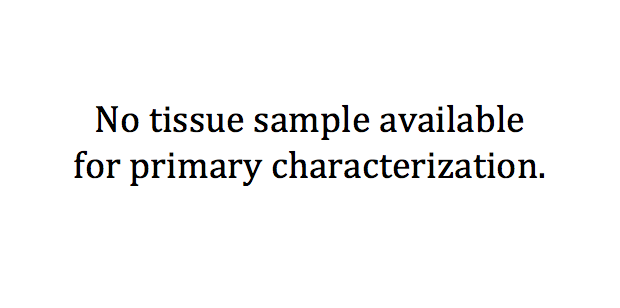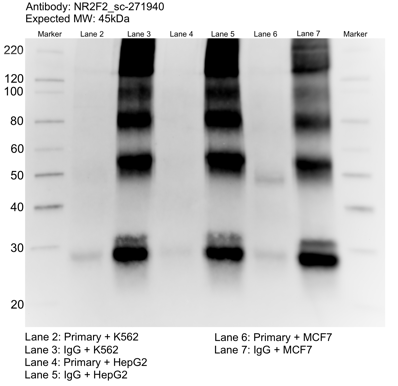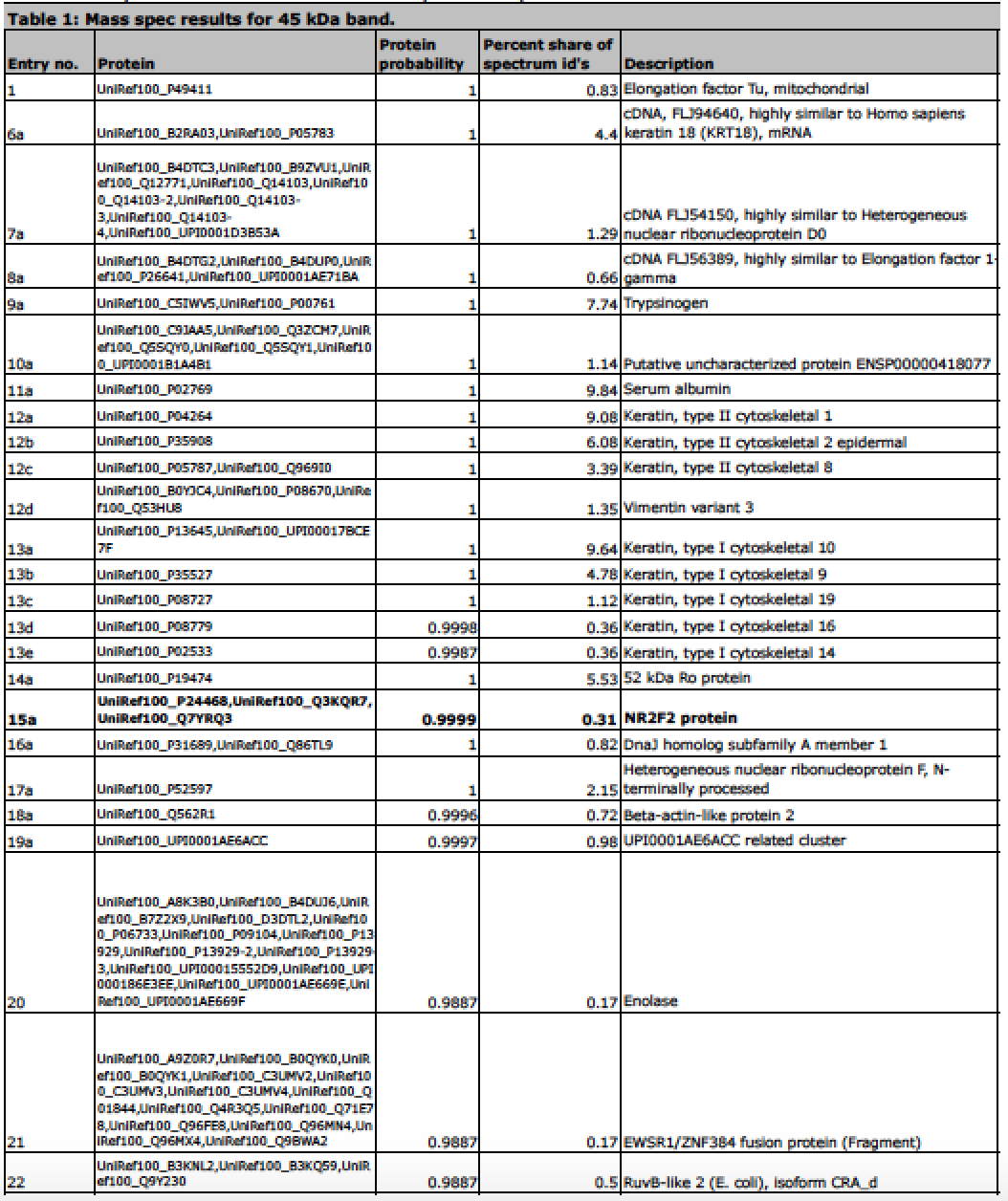ENCAB000AJH
Antibody against Homo sapiens NR2F2
Homo sapiens
K562, HepG2, liver, MCF-7
characterized to standards with exemption
- Status
- released
- Source (vendor)
- Santa Cruz Biotech
- Product ID
- sc-271940
- Lot ID
- I1410
- Characterized targets
- NR2F2 (Homo sapiens)
- Host
- mouse
- Clonality
- monoclonal
- Purification
- affinity
- Isotype
- IgG
- Antigen description
- Epitope mapping between amino acids 13-44 at the N-terminus of NR2F2 of human origin.
- External resources
Characterizations
NR2F2 (Homo sapiens)
K562HepG2
exempt from standards
- Caption
- Western blot protocol: Whole cell lysate was immunoprecipitated using primary antibody, and the IP fraction was loaded on a 12% acrylamide gel and separated with a Bio-Rad PROTEAN II xi system. After separation, the samples were transferred to a nitrocellulose membrane with an Invitrogen iBlot system. Blotting with primary (same as that used for IP) and secondary HRP-conjugated antibodies was performed on an Invitrogen BenchPro 4100 system. Visualization was achieved using SuperSignal West Femto solution (Thermo Scientific). Results: Band of expected size visualized at ~47 kDa. Upper bands also visualized. Both bands tested by IP-mass spec in Validation 2. Figure legend: IP-western with sc-271940 in whole cell lysate (WCL) of K562 and HepG2; PM=protein marker. NR2F2 bands are indicated (as determined by mass spec in Validation 2). Expected size ~45 kDa.
- Submitter comment
- --
- Reviewer comment
- Band is not 50% of overall signal
- Submitted by
- Richard Myers
- Lab
- Richard Myers, HAIB
- Grant
- U54HG004576
NR2F2 (Homo sapiens)
liver
exempt from standards
- Caption
- The ENCODE Binding Working Group finds for some valuable tissues that recreating a primary on well characterized antibodies is not cost effective. Therefore, they allow exemption from standards for these tissues.
- Submitter comment
- The lab is asking for an exemption for liver cells due to the lack of resource to make a primary characterization for them
- Reviewer comment
- Exempted by the Feb 29, 2016 antibody review panel
- Submitted by
- Richard Myers
- Lab
- Richard Myers, HAIB
- Grant
- U54HG006998
- Download
- No_tissue.png
NR2F2 (Homo sapiens)
K562HepG2MCF-7
exempt from standards
- Caption
- Whole cell lysates of K562, MCF7, and HepG2 were immunoprecipitated using the primary antibody (Santa Cruz Biotechnology; sc-271940). The IP fraction was separated on a 12% acrylamide gel with the Bio-Rad PROTEAN II xi system. After separation, the samples were transferred to a nitrocellulose membrane with an Invitrogen iBlot system. The membrane was probed with the primary antibody (same as that used for IP) and a secondary HRP-conjugated antibody. The resulting bands were visualized with SuperSignal West Femto Solution (Thermo Scientific). Protein Marker (PM) is labeled in kDa. The approximate size of NR2F2 is ~45 kDa.
- Submitter comment
- --
- Reviewer comment
- Band is not clearly absent from the IgG control lane and is not strong in the signal lane. Rescued by mass spec
- Submitted by
- Mark Mackiewicz
- Lab
- Richard Myers, HAIB
- Grant
- U54HG006998
- Download
- NR2F2_sc-271940_092916_L.png
NR2F2 (Homo sapiens)
compliant
- Caption
- IP followed by mass spectrometry: Briefly, K562 whole cell lysates were immunoprecipitated using primary antibody, and the IP fraction was loaded on a 12% acrylamide gel and separated with a Bio-Rad PROTEAN II xi system. The gel was stained with Coomassie Blue in order to visualize marker bands. Gel fragments corresponding to the bands indicated above in the western blot image were excised and sent to the University of Alabama at Birmingham Cancer Center Mass Spectrometry/Proteomics Shared Facility. There the samples were run on an LTQ XL Linear Ion Trap Mass Spectrometer by LC-ESI-MS/MS. Peptides were identified using SEQUEST tandem mass spectra analysis, with probability based matching at p < 0.05. As per ENCODE data standards, all SEQUEST results are attached (ENCODE_HAIB_NR2F2_sc271940_12072011_MassSpec.pdf), including common contaminants. Target protein is listed as entry number 15a with 0.9999% probability in the ~45 kDa band and is not present in the upper (~80 and 90 kDa) bands.
- Reviewer comment
- ENCODE2 characterization passes ENCODE3 standards
- Submitted by
- Richard Myers
- Lab
- Richard Myers, HAIB
- Grant
- U54HG004576



